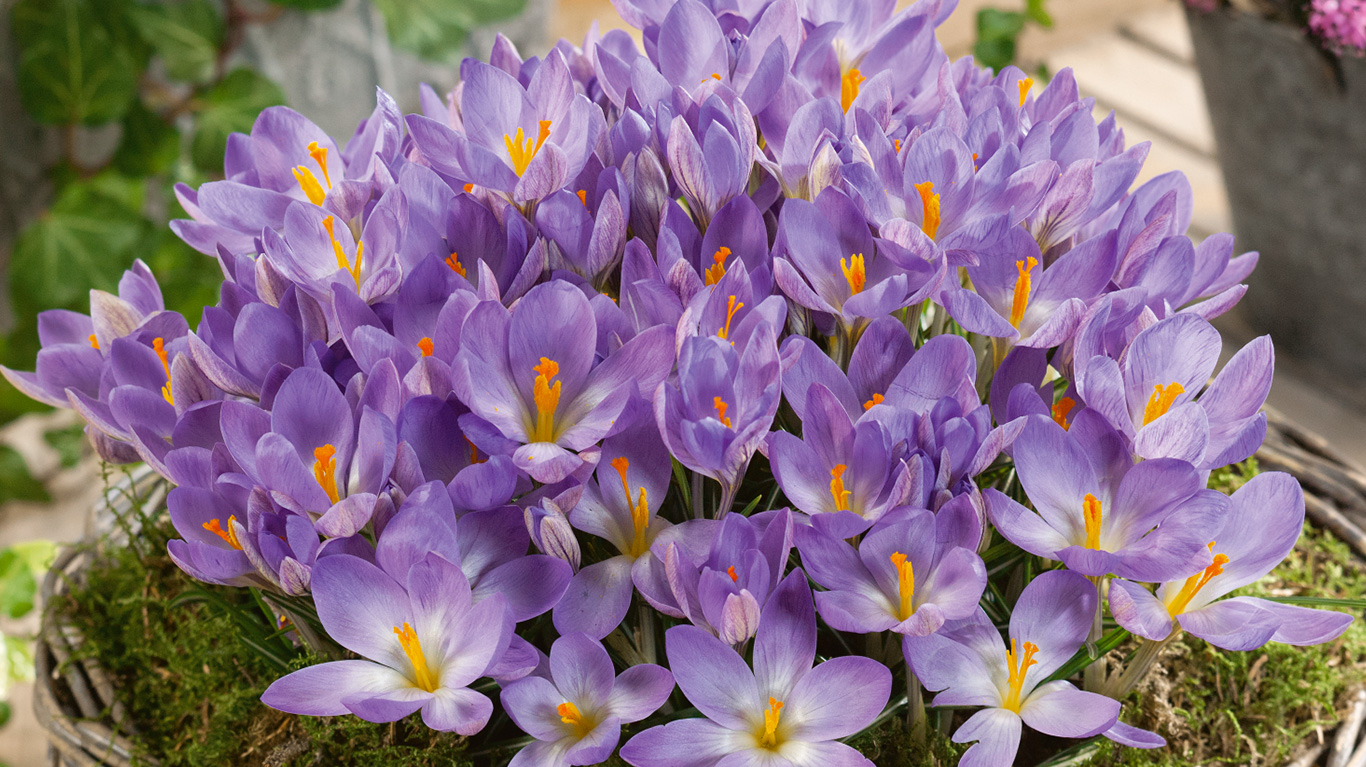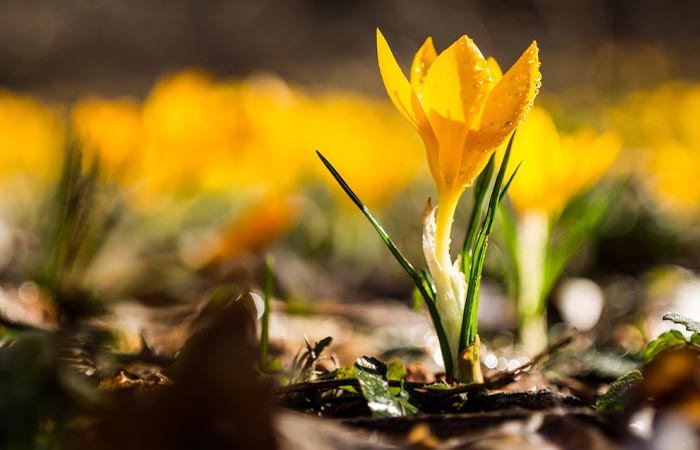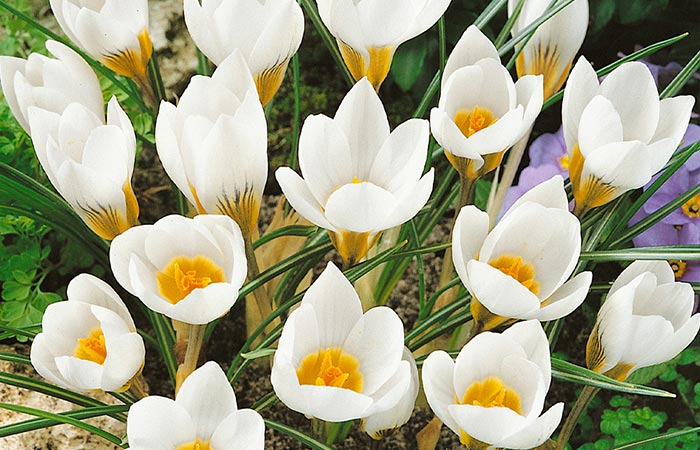
What We've Included
How Supplied | When to Plant | Where to Plant | How to Plant | When will they flower | After Care | Common Issues | Further Reading
How Supplied
Our crocus corms will be delivered fresh and healthy. They should be firm, not soft. Some bulbs may arrive with slight mould patches, but this is completely normal and can be brushed off. If you suspect that your bulbs or corms are faulty, do not hesitate to get in touch.
Once your bulbs arrive, take them out of their packaging and lay out in a box so they can breathe. Put into a paper or mesh bag for storing. This is so they don’t excessively sweat in their containers, ruining the bulbs.

When to Plant
It’s often said that you should plant crocus throughout early autumn. This is true, but you can get away with planting them up to early winter. If you live in extremely cold climates, place some mulch on the top of your soil to keep the bulbs warm through particularly cold weather.
Where to Plant
Crocus corms and bulbs can be planted in beds, borders, containers and through lawns. Crocuses prefer a reasonable exposure to the sun, however, will tolerate light or dappled shade as well.
How to Plant

In Grass
Crocuses are perfect for creating a wild, woodland effect in the garden. That makes them perfect for planting in grass and lawns, where they will naturalise effortlessly. For a natural-looking growth, grab a handful of bulbs and throw them onto the area that you’d like to grow them and plant them where they land. Plant as you would in beds and containers – Bulb pointy side up, 2-3 times the depth of the bulb.
Borders
1. Dig a hole that’s wide enough to fit the bulb/corm comfortably, and at least 2-3 times its depth. Often gardeners choose to plant Crocus bulbs en-masse or in groups. If this is the case, dig a trench instead of individual holes at the same depth to save yourself some time.
2. Add bonemeal and horticultural grit (or spent compost) to the bottom of the hole. This will help the bulbs to grow healthily.
3. Pop each bulb into their holes, pointed side up. Space each bulb twice its width apart.
4. Cover with soil and pat down.
Containers
1. Fill the pot with any multi-purpose compost until you’ve reached its halfway point.
2. Place your bulbs on top of the soil, about 5cm apart.
3. Cover with the compost to the top of the pot. Break up any lumps as you go.
4. Gently press the soil so that it’s nice and flat.
5. Make sure you place your pot on feet to allow the moisture from the pot to escape.
When will they Flower?
Typically, there are three kinds of crocus. Crocus Species, Crocus Vernus, and autumn-flowering.

Spring Flowered Crocus – Crocus Species (Botanical Crocus)
This group of Spring-flowering crocus including Chrysanthus, Tommasinianus and Sieberi types will flower very early in the spring once the sun heats the soil. They are often the first blooms to appear after the cold winter months and provide weeks of colour to the garden. They are often found growing between January and March.

Spring Flowering Crocus – Crocus Vernus (Large-Flowered Crocus)
This group of Spring-flowering varieties usually appear a little later than the species types. They produce taller plants with larger flowers and include some well-known varieties such as Pickwick, Flower Record and Joan of Arc. They are often found growing between February and March, or even until April.

Autumn Flowering Crocus
As the name suggests, the autumn-flowering crocus appears in autumn. They include speciosus types as well as Saffron producing Crocus Sativus. Autumn crocus can be planted in the autumn and flower from September through to October. Perfect for adding colour to your autumn displays! These varieties are usually supplied during their flowering time and will only, therefore, produce a good display in the following year.
After Care
When to water
As long as the soil is moist, there’s no need to water these flowers too often. As the spring season in Britain is usually quite damp, the rain will water them for you! If we’re having an abnormally dry season, then you can water them once a week, but be careful not to waterlog the soil.
What to do once they’ve finished blooming
If you’ve grown your crocus corms in grass, don’t mow until they’ve died back, and the leaves have turned yellow. Crocuses will reappear year after year, as they naturalise well.
Storing tips
Crocuses naturalise, meaning that they multiply once planted. If you want to separate the clumps and plant them elsewhere, this is how.
1. Wait until the plant has died down and has reached a straw colour (often yellow).
2. Dig up the area they’re planted gently. Try not to damage the bulbs in the process.
3. Brush off any remnants of soil and dirt gently and divide them.
4. Replant elsewhere, or store in trays and paper bags in a dry room (10-20°C) until it’s time to replant them.
Deadheading
Deadheading can help redirect the bulb’s energy into creating a new flower once the other one has wilted. It also helps to keep the flower bed looking tidy and uniform whilst the others are still in bloom. Simply cut the spent flower with clean shears, just above the leaves.
Common Issues and How to Solve Them
Grey Squirrels ruining your displays?
Grey squirrels love to dig up bulbs. In borders, plant your bulbs in an aquatic basket and cover them with chicken wire. In containers, simply cover with chicken wire. You can remove this wire once the plant emerges from the ground.
Rot and Mould
When kept in storage, corms are prone to rotting and growing mould if not kept at the right temperature. To avoid this, ensure the room you’re storing them in is around 10-20°C.
Before replanting, check they’re unblemished and aren’t soft in any areas. Throw away if you notice any signs of disease or rot, as they won’t flower and will tarnish your other bulbs and corms.
Want to Know even more about Crocus?
Take a look at our helpful blogs



